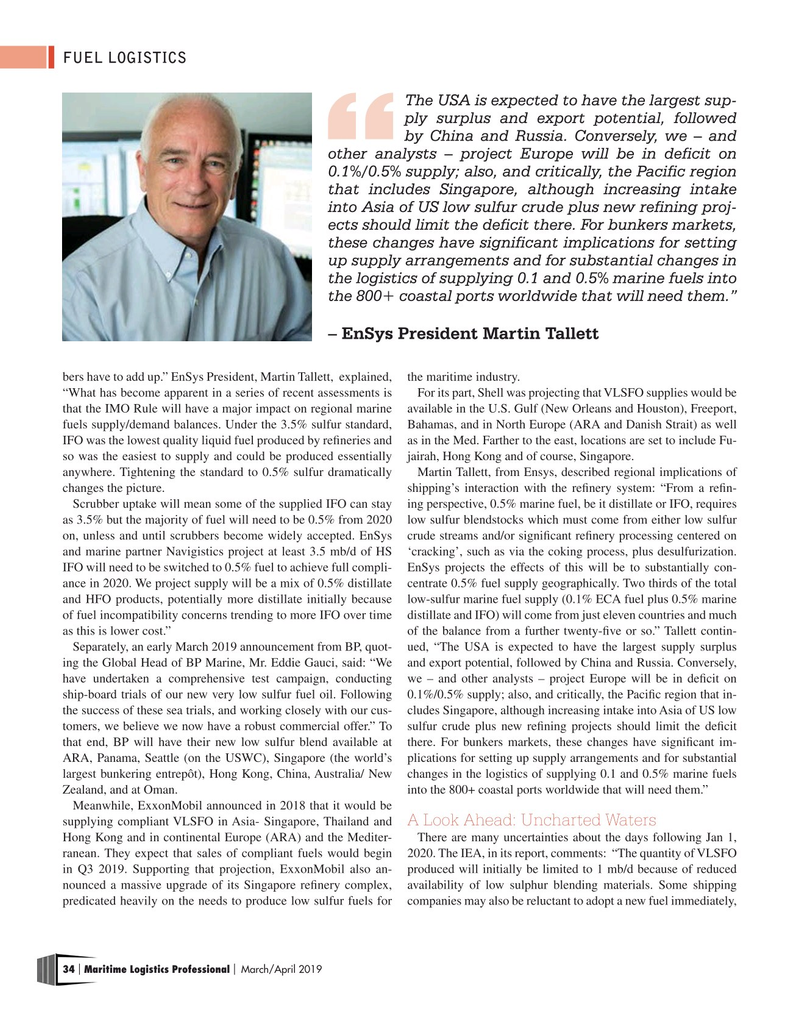
Page 34: of Maritime Logistics Professional Magazine (Mar/Apr 2019)
Container Ports
Read this page in Pdf, Flash or Html5 edition of Mar/Apr 2019 Maritime Logistics Professional Magazine
FUEL LOGISTICS
The USA is expected to have the largest sup- ply surplus and export potential, followed by China and Russia. Conversely, we – and other analysts – project Europe will be in deficit on 0.1%/0.5% supply; also, and critically, the Pacific region that includes Singapore, although increasing intake into Asia of US low sulfur crude plus new refining proj- ects should limit the deficit there. For bunkers markets, these changes have significant implications for setting up supply arrangements and for substantial changes in the logistics of supplying 0.1 and 0.5% marine fuels into the 800+ coastal ports worldwide that will need them.” – EnSys President Martin Tallett bers have to add up.” EnSys President, Martin Tallett, explained, the maritime industry. “What has become apparent in a series of recent assessments is For its part, Shell was projecting that VLSFO supplies would be that the IMO Rule will have a major impact on regional marine available in the U.S. Gulf (New Orleans and Houston), Freeport, fuels supply/demand balances. Under the 3.5% sulfur standard, Bahamas, and in North Europe (ARA and Danish Strait) as well
IFO was the lowest quality liquid fuel produced by re?neries and as in the Med. Farther to the east, locations are set to include Fu- so was the easiest to supply and could be produced essentially jairah, Hong Kong and of course, Singapore. anywhere. Tightening the standard to 0.5% sulfur dramatically Martin Tallett, from Ensys, described regional implications of changes the picture. shipping’s interaction with the re?nery system: “From a re?n-
Scrubber uptake will mean some of the supplied IFO can stay ing perspective, 0.5% marine fuel, be it distillate or IFO, requires as 3.5% but the majority of fuel will need to be 0.5% from 2020 low sulfur blendstocks which must come from either low sulfur on, unless and until scrubbers become widely accepted. EnSys crude streams and/or signi?cant re?nery processing centered on and marine partner Navigistics project at least 3.5 mb/d of HS ‘cracking’, such as via the coking process, plus desulfurization.
IFO will need to be switched to 0.5% fuel to achieve full compli- EnSys projects the effects of this will be to substantially con- ance in 2020. We project supply will be a mix of 0.5% distillate centrate 0.5% fuel supply geographically. Two thirds of the total and HFO products, potentially more distillate initially because low-sulfur marine fuel supply (0.1% ECA fuel plus 0.5% marine of fuel incompatibility concerns trending to more IFO over time distillate and IFO) will come from just eleven countries and much as this is lower cost.” of the balance from a further twenty-?ve or so.” Tallett contin-
Separately, an early March 2019 announcement from BP, quot- ued, “The USA is expected to have the largest supply surplus ing the Global Head of BP Marine, Mr. Eddie Gauci, said: “We and export potential, followed by China and Russia. Conversely, have undertaken a comprehensive test campaign, conducting we – and other analysts – project Europe will be in de?cit on ship-board trials of our new very low sulfur fuel oil. Following 0.1%/0.5% supply; also, and critically, the Paci?c region that in- the success of these sea trials, and working closely with our cus- cludes Singapore, although increasing intake into Asia of US low tomers, we believe we now have a robust commercial offer.” To sulfur crude plus new re?ning projects should limit the de?cit that end, BP will have their new low sulfur blend available at there. For bunkers markets, these changes have signi?cant im-
ARA, Panama, Seattle (on the USWC), Singapore (the world’s plications for setting up supply arrangements and for substantial largest bunkering entrepôt), Hong Kong, China, Australia/ New changes in the logistics of supplying 0.1 and 0.5% marine fuels
Zealand, and at Oman. into the 800+ coastal ports worldwide that will need them.”
Meanwhile, ExxonMobil announced in 2018 that it would be
A Look Ahead: Uncharted Waters supplying compliant VLSFO in Asia- Singapore, Thailand and
Hong Kong and in continental Europe (ARA) and the Mediter- There are many uncertainties about the days following Jan 1, ranean. They expect that sales of compliant fuels would begin 2020. The IEA, in its report, comments: “The quantity of VLSFO in Q3 2019. Supporting that projection, ExxonMobil also an- produced will initially be limited to 1 mb/d because of reduced nounced a massive upgrade of its Singapore re?nery complex, availability of low sulphur blending materials. Some shipping predicated heavily on the needs to produce low sulfur fuels for companies may also be reluctant to adopt a new fuel immediately, 34 Maritime Logistics Professional March/April 2019 | |

 33
33

 35
35
